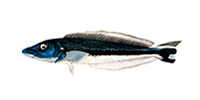Thank you for visiting the Seafood Selector. EDF is planning a new approach to providing information to consumers about good seafood choices. Please come back soon for updates.
Tilefish

Tilefish
Recommended servings per month
| Contaminant | Men | Women | Kids 6-12 | Kids 0-5 | |
|---|---|---|---|---|---|
| Tilefish (Gulf of Mexico/South Atlantic) | Mercury | 1 | 0 | 0 | 0 |
| Tilefish (mid-Atlantic) | Mercury | 1 | 0 | 0 | 0 |
Eco details:
- These deepwater fish are highly susceptible to overfishing. Recent management plans aim to reduce fishing pressure and rebuild stocks.
- Populations in the mid-Atlantic have rebounded as a result.
- In the Gulf of Mexico, grouper and tilefish are now caught under an innovative new ‘catch share’ management plan. In less than three years, discards have already decreased for sensitive species and fishermen reliably stay within their catch limits.




